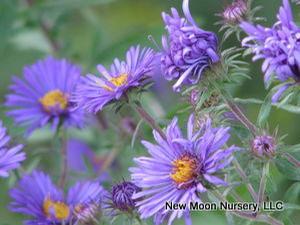New Moon Nurseries
Aster novae-angliae
New England aster
Native to North America
FIRST IMPRESSIONS: Along with the goldenrods and native grasses, asters are the quintessential herbaceous fall color plants of North America. This one is a robust upright perennial with pubescent gray-green leaves. Flowering plants are majestic in fall when crowned with sprays of large starry purple daisies. Plants are tough and adaptable to most moist sunny sites.
HABITAT & HARDINESS: Aster novae-angliae occurs in almost every state or province of North America.
Habitats include moist prairies and meadows, Black Belt prairies, open woodlands, creek or river banks, chalk or clay embankments, roadsides and other disturbed areas.
Plants are hardy from USDA Zones 3-8.
PLANT DESCRIPTION: Aster novae-angliae is a sturdy clump forming perennial with stiff hairy stems.
Leaves are lance shaped, pubescent and up to 4” long. Each leaf clasps the stem and contains two protruding basal lobes.
Large flower heads are arranged in showy panicles. The heads consist of a ring of 40 or more royal purple or pinky-purple ray florets that surround a central cluster of yellow disc florets.
The flowers supply valuable late season nectar for migrating Monarch butterflies. Blooms are also visited by other butterflies, skippers and bees.
Plants grow 3-6’ tall with 2-3’ spread.
CULTURAL & MAINTENANCE NEEDS: Culture is easy in sunny sites with clay, moist well drained soil, or alkaline soil.
Plants tolerate some drought but unattractive or diseased foliage may develop if drought is severe. Plants may also die out in the center if they are not divided periodically.
Aster novae-angliae sometimes has issues with powdery mildew. To prevent the disease give plants good growing conditions and space for air circulation. In gardens, locate this aster in plenty of sun, irrigate during drought and limit overcrowding by using appropriate spacing for companion plants.
Plants can be pruned back to 6” early in the season to control height and promote stronger stems. Cutting should be curtailed by the end of June so that flowers have time to develop. Prune again after flowering if self-seeding is a problem or if foliage is bedraggled.
Plants are fairly unpalatable to browsing deer and rabbits.
LANDSCAPE USES: This is a good choice for a Wildlife Garden, Moist Prairie or Meadow. Plants are also used as Butterfly Nectar Plants or as part of a Grouping or Mass Planting. Aster novae-angliae has Showy Blooms and is appropriate for Cottage Gardens, Deer Resistant Plantings, Water-wise Landscapes, Low Maintenance Plantings, Perennial Borders, Roadsides and Restoration Projects.
COMPANION & UNDERSTUDY PLANTS: Try pairing Aster novae-angliae with Asclepias incarnata, Rudbeckia subtomentosa, Monarda fistulosa, Liatris spicata and Andropogon gerardii..
Aster puniceus would be a suitable replacement due to similar height, flower color and habitat needs. Aster novae-angliae ‘Purple Dome’ could serve as lower growing alternative.
TRIVIA: Many of the established Latin names of Aster spp. were changed recently due to DNA and genetic research findings. So Aster novae-angliae is now known as Symphyotrichum novae-angliae.
Plants host caterpillars of several different moths.
The best identification characteristics of Aster novae-angliae are its pubescent leaves that clasp the stems and its large flower heads that contain more ray florets than most other asters.
Height:
3-6 ftSpread:
2-3 ftSpacing:
4-6 ftUSDA Hardiness Zone:
3-8Bloom Color:
VioletAster novae-angliae Characteristics
Attracts Wildlife
- Butterflies
Attributes
- Naturalizing
- East-Coast Native
- Rain Garden
- Cut Flower
- Clay Soil
Exposure
- Full Sun to Partial Shade
Flowering Months
- September
- August
- October
Foliage Color
- Green
Growth Rate
- Fast
Juglans nigra Tolerance (Black Walnut)
- Yes
Salt Tolerance
- Medium
Season of Interest (Foliage)
- Summer
- Spring
- Fall
Soil Moisture Preference
- Moist to Wet
Interesting Notes:
AKA Symphyotrichum novae-angliae
For more information on this plant, visit the USDA PLANTS Database: http://plants.usda.gov/java/profile?symbol=SYNO2
